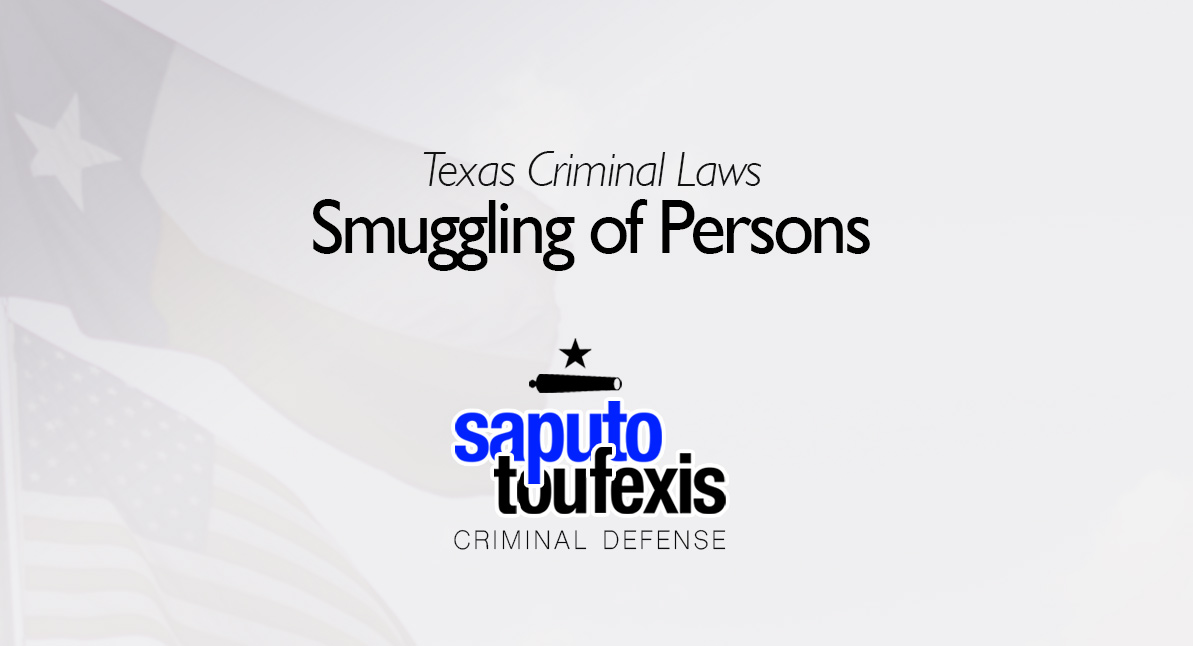The Texas Smuggling of Persons law prohibits knowingly using a vehicle to transport people that the driver intends to conceal from law enforcement or with the intent to flee from law enforcement.
FAQs about the
Smuggling of Persons law in Texas
- What is the current Texas law about Smuggling of Persons?
- How can the state attorneys prove intent to conceal?
- How can the state attorneys prove intent to flee?
- What does second degree affinity mean?
- What does second degree consanguinity mean?
- What is a pecuniary benefit?
- What is the statute of limitation for Smuggling of Persons in Texas?
- What is the penalty for a Texas Smuggling of Persons offense?
- Can you get probation for Smuggling of Persons in Texas?
- What level of crime is Smuggling of Persons in Texas?
In addition, Texas’s human smuggling law prohibits encouraging someone to enter or remain in the USA in violation of federal law by concealing that person from detection, as well as assiting two or more individuals to enter or remain on agricultural land without the consent of the owner. The legislature codified this criminal offense in Texas Penal Code Section 20.05.
Have you been charged with Smuggling of Persons? Contact us today to discuss legal representation.
or Text or Call (888) 239-9305
The Texas Smuggling of Persons law was not updated by the legislature in its 2023 regular session, but it was updated in a third special session in 2023, effective February 4, 2024, by increasing punishment for violations of this offense to ten years in prison, except under certain circumstances.
The offense of Smuggling of Persons can easily be confused with the offense of Human Trafficking. The biggest difference between the two offenses is that the offense of Smuggling of Persons most often involves individuals who are voluntarily being smuggled because the individuals wish to hide from law enforcement. The individuals being smuggled may want to hide from law enforcement because they are attempting to cross into the state illegally or are in the state illegally. Whereas human trafficking involves drivers who transport people with the intent to make them perform forced labor or services such as Prostitution.
However, the state can charge a driver with Smuggling of Persons in addition to other charges if someone alleges that the driver used force against the person being smuggled. For example, if a person agreed to be smuggled but then alleges that the driver restrained them in some way, state’s attorneys may consider adding other charges against a driver in addition to Smuggling of Persons under Chapter 20 of the Texas Penal Code. These other charges can include Kidnapping or Unlawful Restraint.
The Penal Code classifies the Texas Smuggling of Persons law under Title 5 “Offenses Against The Person,” Chapter 20 “Kidnapping, Unlawful Restraint, and Smuggling of Persons.” Learn more about the Texas offense of Smuggling of Persons below.
What is the current Texas law about Smuggling of Persons?
Texas law currently defines the offense of Smuggling of Persons in Penal Code Section §20.05 as follows:[1]
(a) A person commits an offense if the person knowingly:
(1) uses a motor vehicle, aircraft, watercraft, or other means of conveyance to transport an individual with the intent to:
(A) conceal the individual from a peace officer or special investigator; or
(B) flee from a person the actor knows is a peace officer or special investigator attempting to lawfully arrest or detain the actor;
(2) encourages or induces a person to enter or remain in this country in violation of federal law by concealing, harboring, or shielding that person from detection; or
(3) assists, guides, or directs two or more individuals to enter or remain on agricultural land without the effective consent of the owner.
(b) An offense under this section is a felony of the third degree, except that the offense is:
(1) a felony of the second degree if:
(A) the actor commits the offense in a manner that creates a substantial likelihood that the smuggled individual will suffer serious bodily injury or death;
(B) the smuggled individual is a child younger than 18 years of age at the time of the offense;
(C) the offense was committed with the intent to obtain a pecuniary benefit;
(D) during the commission of the offense the actor, another party to the offense, or an individual assisted, guided, or directed by the actor knowingly possessed a firearm; or
(E) the actor commits the offense under Subsection (a)(1)(B); or
(2) a felony of the first degree if:
(A) it is shown on the trial of the offense that, as a direct result of the commission of the offense, the smuggled individual became a victim of sexual assault, as defined by Section 22.011, or aggravated sexual assault, as defined by Section 22.021; or
(B) the smuggled individual suffered serious bodily injury or death.
(c) It is an affirmative defense to prosecution of an offense under this section, other than an offense punishable under Subsection (b)(1)(A) or (b)(2), that the actor is related to the smuggled individual within the second degree of consanguinity or, at the time of the offense, within the second degree of affinity.
(d) If conduct constituting an offense under this section also constitutes an offense under another section of this code, the actor may be prosecuted under either section or under both sections.
Subsection (a) describes the acts that constitute a Smuggling of Persons charge. Subsections (b) and (c) talk about the punishment for this offense. Subsection (d) outlines circumstances that allow a person to bring an affirmative defense (an affirmative defense is a strategy that requires you to prove that, because of certain conditions, you did nothing wrong) against the charge of Smuggling of Persons in cases where the driver is related to the passengers being transported by blood or marriage. Subsection (e) allows the state’s attorneys to add additional charges.
How can the state attorneys prove intent to conceal?
The state can prove intent to conceal in many different ways. For instance, the intent can be found if a driver is holding passengers in a place where they are not likely to be found such as under seats, in the trunk of a car, or in the back of a an 18-wheeler. A state attorney can also prove that the driver had an intent to conceal if law enforcement asked the driver if there were other people in the vehicle and the driver said no, but it was later discovered that there were other people in the vehicle. Relatedly, the definition of “abduct” in Section 20.01(2) of the Texas Penal Code defines abducting a person as as “secretly” holding a person,[2] so it is important to have a criminal lawyer who will prevent a charge of kidnapping from being brought against you in addition to Smuggling of Persons charge.
How can the state attorneys prove intent to flee?
The state’s attorneys can prove intent to flee many ways. One of the easiest is under §545.421 of the Texas Transportation Code. Under §545.421, a person who does not stop their vehicle when signaled to by law enforcement or attempts to drive away from law enforcement, has an intent to flee. Law enforcement can signal a driver to stop with lights, sirens or a hand gesture.
What does second degree affinity mean?
Second degree affinity means that there is a relationship between two people because of a family member’s marriage. Second degree affinity would include people such as a brother-in-law, sister-in-law, spouse’s grandchild or grandparent, or a grandchild or grandparent’s spouse. Section 20.05(d) of the Smuggling of Persons offense states that an affirmative defense is available to a person charged with the Smuggling of Persons offense if the individual allegedly being smuggled is “within the second degree of affinity” to the driver at the time of the offense. The language “at the time of the offense” means that an affirmative defense is available even if the marriage ends after you were arrested.
What does second degree consanguinity mean?
Consanguinity means that two people are blood related. Section 20.05(d) of the Smuggling of Persons offense states that a driver has an affirmative defense if the driver is related to the individual allegedly being smuggled by a “second degree of consanguinity.” A person is within the second degree of consanguinity to another if there is a relationship such as a child/parent relationship, brother/sister relationship, or grandchild/grandparent relationship.
What is a pecuniary benefit?
The punishment for Smuggling of Persons can be a third degree felony if the state’s attorneys show that a driver was committing the offense “for pecuniary benefit.” Pecuniary benefit means for profit. Thus, a driver smuggling people for a pecuniary benefit is being paid to smuggle people.
What is the statute of limitation for Smuggling of Persons in Texas?
Smuggling of Persons offenses have a three-year limitations period.[3]
What is the penalty for a Texas Smuggling of Persons offense?
Smuggling of Persons is a third degree felony offense, but there are factors that can enhance the classification of punishment. In addition, new minimum terms of confinement apply for offenses occurring after February 4, 2024, except under certain circumstances (see the footnote for details).[4] In addition, it’s important to note that because the legislature has amended this law multiple times since 2015, the penalty provisions that apply to older offenses vary depending on the alleged offense date.
Currently, the state can charge the offense as a second deegree felony by alleging any of the following:[5]
(A) the actor commits the offense in a manner that creates a substantial likelihood that the smuggled individual will suffer serious bodily injury or death;
(B) the smuggled individual is a child younger than 18 years of age at the time of the offense;
(C) the offense was committed with the intent to obtain a pecuniary benefit;
(D) during the commission of the offense the actor, another party to the offense, or an individual assisted, guided, or directed by the actor knowingly possessed a firearm; or
(E) the actor commits the offense under Subsection (a)(1)(B)
The state can charge the offense as a first deegree felony by alleging that as a direct result of the commission of the offense, the smuggled individual became a victim of sexual assault or aggravated sexual assault, or by alleging that the smuggled individual suffered serious bodily injury or death.[6]
Amendments effective in 2024
The legislature significantly increased the penalties for violations of this offense, effective February 4, 2024. These 2024 amendments enacted a minimum term of confinement of ten years for violations of this offense, except under certain conditions.[7] Prior to this date, violations of this offense were third degree felonies punishable by a maximum of ten years in prison. Now, that ten years is the minimum term of confinement. As recently as 2015, this offense was only a state jail felony.[8] The legislature has been ramping up the penalty provisions consistently since 2015.
In addition, the 2024 amendments increased the minimum term in prison for all second degree and first degree felony violations of this offense to ten years.[9]
Can you get probation for Smuggling of Persons in Texas?
The Texas Code of Criminal Procedure allows both judges and juries to grant probation for Smuggling of Persons, and judges are also allowed to accept deferred adjudication plea deals.[10]
Note, however, that no matter the offense, neither judges nor juries may recommend community supervision for any suspended sentence of over 10 years.[11] Also, judges may not grant community supervision after a conviction if (1) the defendant used or exhibited a deadly weapon during the commission of the felony or immediate flight thereafter and (2) the defendant used or exhibited the deadly weapon himself or was a party to the offense and knew that a deadly weapon would be used or exhibited.[12]
What level of crime is Smuggling of Persons in Texas?
The Penal Code classifies the punishment for Smuggling of Persons as a first, second, or third degree felony, depending on the circumstances, all with a minimum term of confinement of ten years, except under certain circumstances.
Learn more about the penalty range for this offense in the section above.
Legal References:
^1. Texas Penal Code §20.05. This law is current as of 2024.^2. Texas Penal Code §20.01(2)(A) – “‘Abduct’ means to restrain a person with intent to prevent his liberation by: (A) secreting or holding him in a place where he is not likely to be found.”^3. See Code of Criminal Procedure 12.01(9)^4. Those “certain cirumstances” are defined in Texas Penal Code §20.05(b-1)&(b-2), as amended by SB 4, 88th Texas Legislature (SS-3) as follows:
(b-1) If at the punishment stage of the trial or at the time of entering a plea agreement for an offense under this section punishable as a felony of the third degree, the attorney representing the state in the prosecution of the offense certifies to the court in writing that the actor has provided significant cooperation to the state or law enforcement, and describes the manner of cooperation, the minimum term of imprisonment is five years. The certification is confidential and shall be sealed by the court, except that the certification may be accessed by the office of the attorney representing the state, the attorney representing the defendant, and the court. For purposes of this subsection, “significant cooperation” includes:
(1) testifying in a trial on behalf of the state against other parties to the offense;
(2) providing relevant information regarding the case and other parties to the offense;
(3) providing information that furthers the investigation of the charged offense and any other parties involved; or
(4) providing information that aids law enforcement.
(b-2) At the punishment stage of a trial of an offense under this section, other than an offense punishable under Subsection (b)(1)(A), (C), (D), or (E) or (b)(2), the actor may raise the issue as to whether the actor is related to the smuggled individual in the third degree of consanguinity or, at the time of the offense, in the third degree of affinity. If the actor proves the issue in the affirmative by a preponderance of the evidence, the offense is a felony of the third degree with a minimum term of imprisonment of five years.
^5. Texas Penal Code §20.05(b)(1)^6. Texas Penal Code §20.05(b)(2)^7. Texas Penal Code §20.05(b), as amended by SB 4, 88th Texas Legislature (SS-3), Section 3^8. See HB 11, 84th Texas Legislature (RS), Section 14^9. Texas Penal Code §20.05(b)(1)&(b)(2), as amended by SB 4, 88th Texas Legislature (SS-3), Section 3^10. See Chapter 42, Texas Code of Criminal Procedure, Art. 42A.054, Art. 42A.056, Art. 42A.102^11. Art. 42A.053(c), Texas Code of Criminal Procedure^12 Art. 42A.054(b), Texas Code of Criminal Procedure










